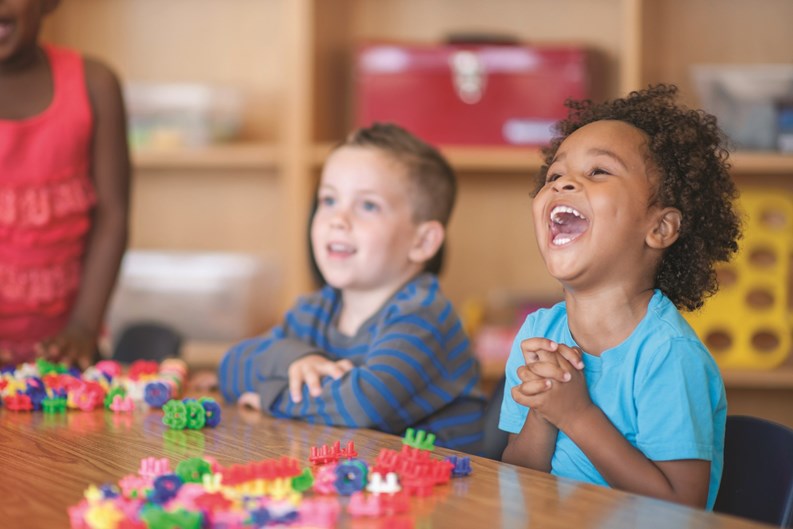As times change and we encounter life’s transitions, many of the things we once desired take on new forms and shapes. None of those transitions is quite as profound as starting—and raising—a family, and for co-op and condo owners who are also parents, having in-house amenities and programming that support them in the job of bringing up young kids is increasingly important. Parent-owners want their building or HOA to provide them with safe, stimulating spaces and activities—and both developers and boards are doing just that, sometimes in places where they had never existed before.
Younger Residents, Different Needs
Developers and clued-in boards alike know that buildings and associations that take into account the needs of a changing community demographic tend to do better on nearly all fronts, including resale value. Needs have a tendency to change too. We want to keep our children close in a world that is more unpredictable than ever—and while we don’t want them cooped up inside and bored, it is hard to allow them to venture out as we once did. Long gone are the days of stickball in the streets, or playing jacks on the sidewalk. As our children become more sophisticated and tech-savvy, keeping up with the times can prove daunting to both parents and to those tasked with programming activities for kids in multifamily communities.
That said however, the child at play has remained regardless of the times. You’d be hard pressed to find a child who can resist the allure of a jungle gym or swing set. Not only does it entertain them, it encourages an active, healthy lifestyle cleverly disguised as frolicking. John McConkey is the market insight manager for Landscape Structures, a company located in Minnesota that provides playground equipment and structures nationwide. “Kids haven’t changed,” he says. “They still want to swing, and slide, and climb and spin. It’s important to appreciate the value of play.”
One of many questions often posed to realtors and property managers is the proximity and density of local parks and playgrounds but increasingly, parents don’t have to look any further than right inside the building they’re buying into.
The Kids Are Okay
Time was, if your building had a gym with a treadmill and some dumbbells, or maybe a lounge with some couches and a pool table, you were all set. It’s only fairly recently that kid- and family-focused amenities became a consideration in newly constructed buildings and existing communities alike. According to Scott Stewart, a real estate broker who has been with the New York based Corcoran Group for 20 years, the trend of those who are already parents or parents-to-be beginning to consider the spaces and amenities available for children has really only been in full swing the last 15 years or so. Times change, and when you start to notice more strollers and car seats, you start thinking. Developers must be mindful of these growing trends as well.
When it comes to kid- and family-friendly amenities however, everything from a teeter-totter to an arts-and-crafts room count toward making a community attractive to families. Some buildings just provide space—in the form of a playground with equipment, or the aforementioned art room—while others have committees or hired pros put together organized outings to zoos or museums, as well as in-house activities like crafting workshops, book clubs, or other fun diversions for their community’s youngest members.
It’s Better With Friends
If your building or HOA is looking to develop kid-centric programming, you don’t have to do it all by yourselves. There are plenty of opportunities to partner with companies that specialize in friendly spaces and events for kids.
Murray Hill’s Waterside Plaza is one facility that has a state-of-the-art outdoor playground. However, buildings like Emerald Green, 320 West 38th Street; the Regent at 45 West 60th Street; Ariel West at 245 West 99th Street; the Brompton at 205 East 85th Street; One Brooklyn Bridge Park at 360 Furman Street; and the Dillon at 425 West 53rd Street, are but some of the developments that offer plush indoor children’s playrooms, which in Manhattan seems to be more the norm.
One need look no further than Kidville, based in Manhattan. Kidville operates upscale facilities that cater to newborns through five years of age, as well as their families, offering activities and programs tailored to each developmental stage, as well as indoor play areas and kid-centric boutiques in the company’s brick-and-mortar locations.
Kidville engaged in an exclusive partnership with nationwide Extell Development Company on two separate properties in New York City: The Rushmore on the Upper West Side and The Lucida on the Upper East Side, offering free membership and developmental classes at nearby Kidville locations for unit owners.
And while some buildings have outsourced their kid-friendly amenities to professionals, others are opting to keep it all under one roof. Stewart himself is a resident of the Ariel West on Manhattan’s Upper West Side that includes a gated courtyard with a jungle gym for the building’s pint-sized community members. In addition to the play equipment, kids of all ages and parents alike can shoot some hoops on the half court basketball court and take a dive—or a basic swimming class for kids—in the building’s swimming pool. There are even fitness classes scaled for little ones at the building’s in-house exercise studio.
Another community committed to providing engaging, worthwhile programing and activities for resident kids is the Solaria in Riverdale in the Bronx. Chris Zedano, the Solaria’s resident manager says that providing things for kids to do, and safe places for them to do them is about more than just designating a lounge area or installing an entertainment system, or even having a fully-functional observatory, which the Solaria has on-site. “It’s about the neighborhood,” says Zedano. “People want a place where they can feel safe. That brings peace of mind,” as well as a better sense of community, of knowing who one’s neighbors are, and sharing a mutual sense of neighborliness and cohesion that can easily be lost amid the hustle and stress of living in a high-density urban setting.
For example, Related Companies’ luxury condo, the Brompton, appeals to the younger set, says Jessica Scaperotti, the company’s vice president of corporate communications, and almost every Related residential building has an amenity space specifically designed for younger residents, she says.
“The Brompton’s space was built to accommodate children of all ages,” Scaperotti says. “During the day, the space is designed for toddlers and younger children with a matted play area and a variety of toys. Then, at 4 p.m., the room is reorganized for the pre-teens living in the building. The space is converted and older children are able to play Ping-Pong, Xbox, and other video and board games. Adjoining the “playroom” is an outdoor terrace where they can go to play games outside and enjoy some sun and fresh air.”
She notes that the building has dedicated staff responsible for turning the room over before the older kids come home from school, and then again for the youngsters in the morning.
“Having these types of amenities in our buildings promotes an overall sense of community and gives our younger residents a place to call their own,” Scaperotti says.
Stewart agrees. “These amenities allow children and parents to meet and become friendly.”
Whether you’re living in a high-rise in the heart of a big city, or in a more spread-out suburban HOA, that sense of safety and community adds a value to homeownership that is beyond just dollars and cents. And the trend today is moving back to cities from the suburbs. Hence, the search for child-friendly amenities.
By providing communal play spaces in buildings, children can have a place to play and interact socially with other kids, which is outside of their apartments, but still within a relative comfort zone. If you are a parent who doesn’t like stepping on a pile of Legos en route to your morning coffee, a play space can help keep toys somewhat contained. If you don’t want to have to tidy up your apartment every time you host a multi-kid play date, you can take them down to the playroom and let them play all they want.
In addition, as the pros point out again and again, playrooms and children’s programming allows kids to have a communal play date where they meet their neighbors, allowing them to have friends within their building, instead of just at school or among their own siblings. So it increases their social network of playmates.
And there’s another perk as well, say the pros; children’s amenities, in buildings that have them, tend to get more use than some of the other, more exotic amenities available in newer buildings—even gyms and media rooms. Kids are extremely active and – for better or worse— are never going to get tired of playing.
Companies like Kidville have gone through all of the necessary red tape in order to function the way they do, safely and securely. This allows the simple installation of their equipment into various areas with little intervention but still are subject to the standards of organizations such as the International Playground Safety Institute (IPSI), The American Society for Testing and Materials (ASTM) and the U.S. Consumer Product Safety Commision. It is left up to the primary caregivers to administer supervision in these spaces, with the possible exception being areas that have considerable surveillance, or the rare association that hires outside supervisory staff.
Whether your building or association opts to designate a rarely-used lounge as a playroom, or puts together a programming committee devoted to organizing outings for families with young kids, or goes all out and installs a playground complete with jungle gym and swingset, you can bet that it will be a much-used, much-loved addition to your building community.
Oba Gathing is a freelance writer and new contributor to The Cooperator.










Comments
Leave a Comment